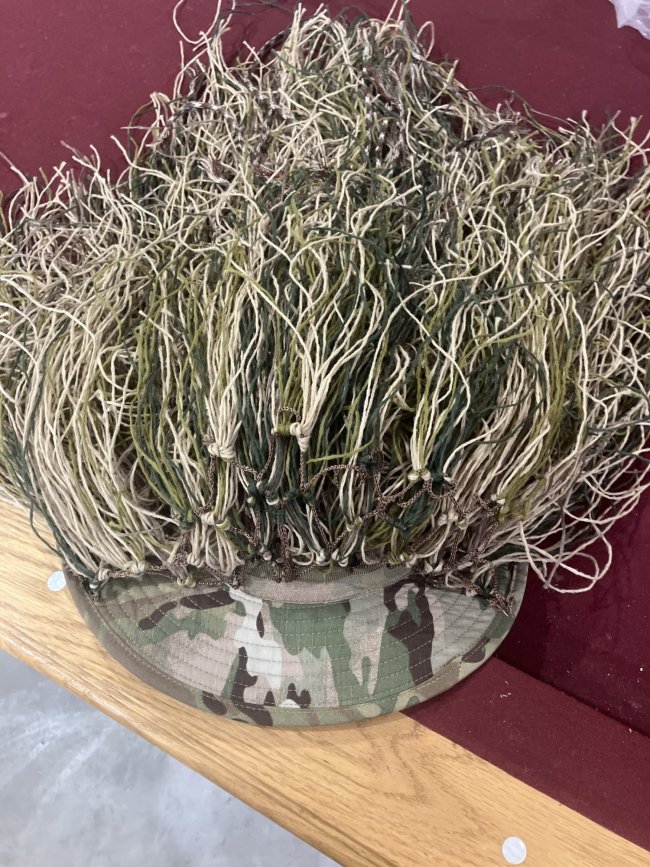Hey guys. Quick guide on making a ghillie veil.
Milspec boonie
Nylon net
Heavy duty thread
100-300 feet 550 para
2-3 bundles of jute.
Start off with a good milspec boonie. Make sure it’s the right cotton/poly blend milspec material. Next you will take some nylon netting and stretch over the boonie and temporarily secure with small zip ties.
Netting temporary held with zip ties:

You want the netting kind of loose. Don’t worry too much what it looks like. It will have to be bunched up on the front and back, and that’s fine. You can sew the net on top of itself in some places and you will have to because of shape of the hat. Leave extra netting hanging just off the hat all the way around the rim.
Next you need to sew the net every one or two cross sections. You can add a dot of glue on the knot to keep it from fraying/untying.

Take your time and take care to secure the netting.

Sew the netting all over the top of the hat except the front sun bill.
As shown below, for the front of the hat sew a line of netting but don’t sew the netting to the front edge of the hat. This will give you some netting to secure jute and 550 para that can be flipped back over to get it back on top of the veil rather than on the shooters face.

Prepping you 550:
You need 100-300 feet of 550 (nylon) para cord. Cut to 14-36 inch lengths and remove the “guts” strands inside and save or discard them.

Fray the edges and then use a lighter to heat the nylon 2-3 inches from the frayed end and then pinch with pliers.

Start adding camo colored jute and 550 para.
Use only 5-7 individual jute strands per square side of netting and start from the bottom. Remember the jute strands double when you loop them and pull them down to secure them. So 5-7 strands ends up 10-14
The you can start to add the 550 for vegetation ties:

See below how I have a small triangle of netting that hangs off the back and allows me to tie jute and 550:


Milspec boonie
Nylon net
Heavy duty thread
100-300 feet 550 para
2-3 bundles of jute.
Start off with a good milspec boonie. Make sure it’s the right cotton/poly blend milspec material. Next you will take some nylon netting and stretch over the boonie and temporarily secure with small zip ties.
Netting temporary held with zip ties:

You want the netting kind of loose. Don’t worry too much what it looks like. It will have to be bunched up on the front and back, and that’s fine. You can sew the net on top of itself in some places and you will have to because of shape of the hat. Leave extra netting hanging just off the hat all the way around the rim.
Next you need to sew the net every one or two cross sections. You can add a dot of glue on the knot to keep it from fraying/untying.

Take your time and take care to secure the netting.

Sew the netting all over the top of the hat except the front sun bill.
As shown below, for the front of the hat sew a line of netting but don’t sew the netting to the front edge of the hat. This will give you some netting to secure jute and 550 para that can be flipped back over to get it back on top of the veil rather than on the shooters face.

Prepping you 550:
You need 100-300 feet of 550 (nylon) para cord. Cut to 14-36 inch lengths and remove the “guts” strands inside and save or discard them.

Fray the edges and then use a lighter to heat the nylon 2-3 inches from the frayed end and then pinch with pliers.

Start adding camo colored jute and 550 para.
Use only 5-7 individual jute strands per square side of netting and start from the bottom. Remember the jute strands double when you loop them and pull them down to secure them. So 5-7 strands ends up 10-14
The you can start to add the 550 for vegetation ties:

See below how I have a small triangle of netting that hangs off the back and allows me to tie jute and 550:








